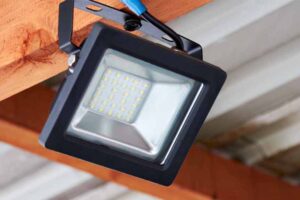A lighting system based on the DMX light control protocol for dimming control is called a digital lighting system. At present, various stage lighting equipment, including stage lights, dimming controllers, consoles, color changers, electric booms, and other stage lighting equipment, including computer lights, have fully realized the digitalization of the dimming system, and based on this, it gradually becomes computerized and networked. Therefore, for film and television lighting design and operators, it is necessary to understand the program structure, control principles, and application points of the DMX512 control protocol.
Table of Contents
1. DMX512 lighting control protocol
DMX is the abbreviation of Digital MultipleX, which means multiple digital transmission. The DMX512 control protocol is an industry standard for data transmission between lighting controllers and luminaires issued by the American Stage Lighting Association (usITT) in 1990. The full name is USITT DMX512 (1990), including electrical characteristics, data protocols, data formats, etc.
Each DMX control byte is called an instruction frame and is called a control channel, which can control one or several functions of the lighting equipment. A DMX instruction frame is composed of a start bit, 8 data bits and 2 end bits, which are composed of 11 bits, and adopts a unidirectional asynchronous serial transmission.
The start bit width is one bit, which is the start flag of the controlled lamp ready to receive and decode the control data; the end bit width is two bits, which indicates the end of an instruction frame; 8-bit control data, and its level combination is from 0000 to 1111111, which has 256 states (corresponding to 0 to 255 decimal numbers). When controlling the brightness of the light, 256 brightness levels can be generated, 0000 ~ (0) Corresponding to the darkest light, 11111111 (255) corresponding to the brightest light. The bit width (per bit width) of the DMX512 instruction is 4 us, each frame width is 44 us, and the transmission rate is 250 kbps.
A complete DMX512 packet (Packet) consists of one MTBP bit, one Break bit, one MAB bit, one SC, and 512 data frames. MTBP (Mark Time Between Packets) marks the completion of sending a complete packet, which is the “idle bit” that the next packet is about to start. It is active high. The break is an interrupt bit, corresponding to the program reset phase after the end of a packet, and the width is not less than two frames (22 bits). The control data should be sent after the program reset, but since the first bit (ie, the start bit) of each data frame is low, two low pulses must be used before and after a high pulse interval. The high-level pulse of the separation function is MAB (Mark After Break). When this pulse arrives, it means that the “new round” of control has begun again. SC (STart Code) means the start code frame. It is composed of 11 bits like the data frames that come later. Except for the two high-level end bits, the other 9 bits are all It is a low level, which is usually called the 0th frame or the 0th channel (Ch ~ nel No 0), which can be understood as a non-existent channel (NON_istent Channe1).
Each time a dimming console sends an information packet, it can form complete control of all 512 controlled channels. The time to send a packet is about 2.3ms, and it will perform 44 controls on all 512 controlled channels per second, that is, the refresh frequency of the controlled optical path is 44 Hz. If the controlled channel is less than 512, the refresh frequency will be improved accordingly.
2. The basic mechanism of the DMX512 light protocol
A DMX interface can control up to 512 channels, because scanners generally have several to dozens of functions, so a computer light needs to occupy a few, as many as dozens of control channels.
3. Several application problems of DMX512 light control protocol
When using the DMX512 protocol to control digital lighting equipment, you also need to have some understanding of the application characteristics, starting address code, unit load, and signal terminator of the DMX interface.
3.1 Application Features of DMX Light Interface
The DMX512 standard stipulates that the DMX interface uses a 5-core card, in which 1 core is grounded, and 2, 3, and 4, 5 cores transmit control signals (2, 4 are inverting ends, 3, 5 are non-inverting ends), and 4, 5 cores are original. It is intended to transmit information about the status of the lighting equipment and error detection, etc., and then left idle.
The reason why the 5-core card socket is required instead of the more common 3-core card socket is to prevent accidental connection with the 3-core card socket commonly used in professional audio because the 3 the core card can provide 48 v phantom voltage to the external interface. This kind of wrong connection can easily damage the internal circuit. However, many scanners still use a 3-core card adapter. If two types of card adapters coexist, the adapter must be used for the correct transfer.
All digital lighting equipment has a DMX input interface and a DMX output interface. The DMX512 control protocol allows a variety of lighting equipment to be mixedly connected. The DMX output interface of the previous device and the input interface of the next device can be directly connected. But it needs to be clear that this seemingly serial link architecture is parallel to the DMX control signal. Because the DMX control signal enters the lighting equipment and is divided into two channels, the voltage is compared, amplified, shaped by the op-amp circuit, and then the command pulse is decoded, and then the stepper motor is controlled by the drive circuit to complete various Control action; the other way is directly transported to the next lighting device after buffering and isolation. Also, from the voltage comparison function of the op-amp, it is not difficult to draw such a conclusion: the high common-mode rejection of the op-amp circuit can greatly improve the anti-interference ability of the DMX control signal, which is why the DMX512 control The reason why the signal adopts balanced transmission.
3.2 Start address code
Each lighting device based on the DMX512 control protocol needs to be assigned a digital start address number, which is the address code of the lighting device. The address code is used to address the DMX512 control signals to ensure that the device only responds to its control signals.
The address code is the starting serial number of the lighting equipment control channel.
When the channel number (frame number) of the DMX512 information packet is the same as the address code of a certain lighting device, that is, the assigned channel start number, the device starts to decode the DMX512 control signal and generates a control action. At the same time, other lighting equipment on the same link did not respond to the DMX512 control signal. Until the control channel number of the DMX512 information packet transitions to the same channel starting sequence number assigned by the next lighting device, the device stops being controlled, and the address code of the next lighting device comes into play and is in a controlled state.
Take scanners as an example. Assuming that a DMX control port drives several scanners, the starting address code of the first scanner is 001, and the starting address code of the second scanner is 001 plus the DMX channel of the first lamp number, and so on. For example, if the number of channels of the first and second scanners is 16 and 20 respectively, the starting address code of the first scanner is 001, the starting address of the second scanner is 017, and the third computer is The starting address code of the lamp is 037. The sum of the start address code of the last scanner and its channel number cannot exceed 512. If there are remaining scanners, the next DMX control interface of the console should be enabled.
There are two ways to set the starting address code of digital lighting equipment: digital and dial-up. Generally, the setting method is relatively simple.
3.3 Units of Load of Scanners
According to the DMX512 protocol standard, each DMX interface can only control a maximum of 32 unit loads on the premise that the total number of channels controlled by the DMX does not exceed 512. When there are more than 32 scanners, silicon boxes, color changers, or other lighting equipment supporting the DMX512 control protocol, but the total number of control channels is far from 512, a DMX distributor can be used to divide one DMX signal into multiple DMX branches. On the one hand, it is convenient to connect the various lighting equipment on the lampstand, and on the other hand, each branch can drive 32 unit loads. However, the total number of channels controlled by each DMX branch on the same DMX link cannot exceed 512.
3.4 DMX Light Terminator
The DMX terminator is an XLR connector connected to the DMX output interface of the last lighting device of each DMX branch. The connector should be connected to a resistor with a resistance of 120 Ω and a power of about 1 W. The end of the DMX branch is closed. Due to the high frequency of DMX control pulses, when the transmission line is unavailable, it has the nature of returning from the original path. In this way, the signal returned from the original path will be superimposed with the subsequent signal, which will easily cause the DMX control command to generate error codes and make the computer lights abnormal. Decoding, motion errors or control failure.
Therefore, connecting a terminal to the DMX output interface of the last scanner will help ensure the stable operation of the scanner.
Summary of DMX Lighting
Compared with the traditional analog dimming system, the digital lighting system based on the DMXS12 control protocol brings great changes to the lighting effects of large and medium-sized film and television studios and variety shows with its powerful control functions. However, the DMX512 lighting control standard also has some shortcomings, such as the speed is not fast enough, the transmission distance is not far enough, wiring and initial settings become too cumbersome as the system size increases, and the control data can only be transferred from the control end to the controlled unit. Unidirectional transmission, can not detect the working condition and online status of the lamp, and transmission errors easily occur. Later, the revised DMX512-A standard supports two-way transmission. It can return information such as error diagnosis reports of lamps and is compatible with all DMX512-compliant lighting equipment. Besides, the decoding circuits of some lighting equipment support 12-bit and 12-bit data expansion modes for more precise control.
If you have any questions about lighting fixtures with dimming or DMX systems, welcome to contact us directly.






3 Comments
Leave your reply.